QuestionI Cathy,
About 2 wks ago I was adopted by a lost dog. She wandered into my yard. I dont hate dogs, I like dogs. My daughters dog lived to be 18yrs old, I am used to dogs around...that get along with my two cats. I managed to feed the dog and she joyfully entered my home after two bowls of cat food.
I have tried all means to find the owner/family. I fear she may have been dropped off from somewhere else. She is house broken and likes my granddaughter (2yr old), she seemed to like my cats too (2 of them), for a while. But as the days turned into weeks, she has gotten very possessive of me and will not let anyone near me, cats or humans. Although she submits when I growl at her for going after the cats or even appearing to, I havent been able to stop her from doing so. If not for that I might even keep her since no one has called about a lost dog for more than two weeks. I live alone and its nice to have someone bark when the doorbell rings. How do I make her realize that the cats were here first and I wont give them up (they too are rescue kitty's, one only has 3 legs)...please help.
Thank you in advance.
AnswerHi Karen,
I'm pretty much a dog person only and haven't had too much dealing with introducing a dog to a home with existing cats. We always recommend that the introductions be done slowly and I always follow the recommendations of another trainer. I have pasted her article below in hopes that it will help:
Introducing a New Dog to a Resident Cat
The following includes information adapted from "Creating a Peaceable Kingdom: How to Live with More Than One Pet" by Cynthia D. Miller and from various PAW volunteers.
* Understand differences in social order. To cats, physical place is all important. To dogs, social place is all important. As long as the dog accepts the cat's dominance over territory, they typically work out a relationship.
* As with introducing pets, think positively. Act with authority and confidence. What you feel and think translates to your actions, and your animals sense your emotions.
* Dogs and cats do not communicate the same way and have trouble understanding one another. For example, a dog will lift his paw gesturing that he wants to play, but a raised paw to a cat is a threat.
* A good-natured, well-trained resident dog often accepts a young cat as a member of the family rather easily. In contrast, introducing an adult cat to a puppy can be hard on the cat. Puppies are rambunctious and full of energy.
* Keep the dog on leash during introductions. Use a halter for very young dogs. Try to keep the leash loose.
* Take dogs to puppy obedience and regular obedience school and teach desired behavior using positive reinforcement. Your dog needs to always remember you are the leader.
* Confining a puppy or dog is necessary at times. It gives the cat time to roam about the house, surveying his territory. If you keep the dog separated with a gate or in an exercise pen, your cat can safely investigate the newcomer.
* When you leave the house, separate the animals in physically, securely separated areas. Give each access to water, a bed or other suitable resting place, and some toys. Be sure the cat has access to a litter box. Make sure everyone in your family and any caretakers understand the need to separate the animals.
* For the cat's safety, make sure the cat has escape routes to get away from the dog. For example, a cat door leading to another room in the house and ledges on which he can easily jump. Always provide places where each animal can retreat for safety and privacy, a spot that is his or hers alone. A cat can use the top of the refrigerator; a dog can use a crate.
* Use a baby gate so they can get to know each other without coming into full contact. Or confine the new pet to a room and allow the animals to sniff each other under the door. A tip from PAW volunteer Lynne Keffer: put up a baby gate at the top of a stairway or in a doorway. (Stack gates one atop another if the dog's a jumper.) Cut a small hole in the gate, just big enough for the cat to fit through. Things typically improve once the cat learns he has an escape hatch.
* Other escape hatches include floor-to-ceiling climbers and installing extra-long hooks and eyes in doors to prop a door open just wide enough for a cat.
* Teach the dog the "leave it" command, and use this command when you want the dog to leave the cat alone. Also teach the dog the "down" and "stay" commands so that you can place her in a down-stay in the presence of the cat.
* Praise the dog when she doesn't bark or want to chase resident cats, advises PAW volunteer Ginnie Maurer. Praise and reward the dog for any calm behavior around the cat. Do this consistently, not just once in awhile.
* Praise a cat when he's gentle around the dog. Keep the cat claws clipped short so if they do connect with the dog, the damage will be minimized.
* Observe your pets so that you can catch them in the act of being good. Give them ample opportunities to earn praise so that they learn what is acceptable behavior. Reinforcing good behavior is the key to encouraging animals to repeat that behavior instead of engaging in undesired behavior.
* Food can be a powerful motivator. You can use food treats to reward a dog for choosing to look at and listen to you in the presence of the cat, instead of chasing the cat.
* Keep dog toys nearby. Direct the dog to a toy and away from the cat when the dog gets rambunctious. Make sure cats have access to their own toys too, so they're less likely to target a dog's tail as a plaything.
* Make sure to give the dog plenty of exercise so that he has less energy to channel into chasing and otherwise bothering the dog.
* Let animals sniff each other -- that's how they get acquainted.
* Avoid overreacting to hissing, barking or growling. These are common ways for animals to communicate. However, be ready to intervene if hostility mounts.
* Do not expect the pets to become buddies right away. Let the animals establish the relationship at their own pace. Realize that some dogs and cats will not become buddies.
* A puppy's innocent behavior can trigger a serious scratching from a wary cat, so as always, it's important to keep watch.
* Prevent the dog from having access to the kitty litter box. Keep the box in a room that's physically off-limits to the dog. Dogs like to eat cat droppings, which are very unhealthy for them.
* To keep a dog from chasing or stalking cats when you are home but otherwise occupied, use a crate or tether the dog to a heavy piece of furniture, suggests Ginnie. Or use a long leash that's tied at your waist.
* Keep in mind that predatory behavior comes naturally to both dogs and cats. They like to chasing moving objects, including other animals.
* If you have more than one dog, do not let them gang up on a cat.
* Be sure to pay attention to the resident pets. Take care not to give all your attention to the newcomer.
* During mealtimes, each animal needs to feel safe and relaxed while eating. An animal who feels the need to defend his food is under much stress (this will also affect digestion). At least initially, feed in separate areas and give the animals their own food bowls. It helps to give the cat an elevated place to eat that cannot be reached by the dog. The height gives the cat a sense of security.
* Introduce new pets when things are going well at home. Do not bring a new pet home during a stressful time in the household.

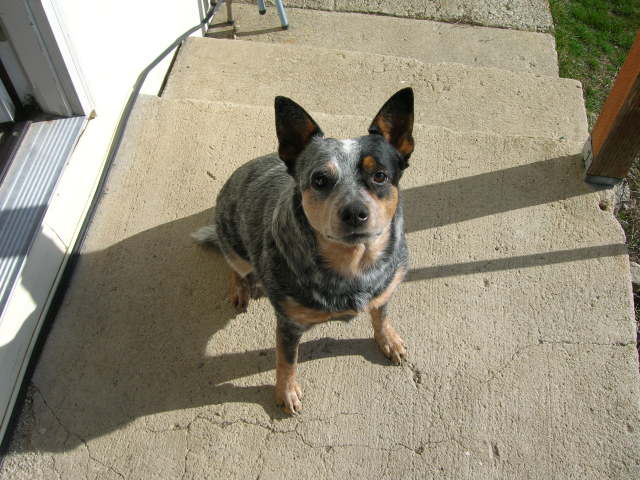 scratching carpet
QuestionQUESTION: Why has our 4 year-old female red hee
scratching carpet
QuestionQUESTION: Why has our 4 year-old female red hee
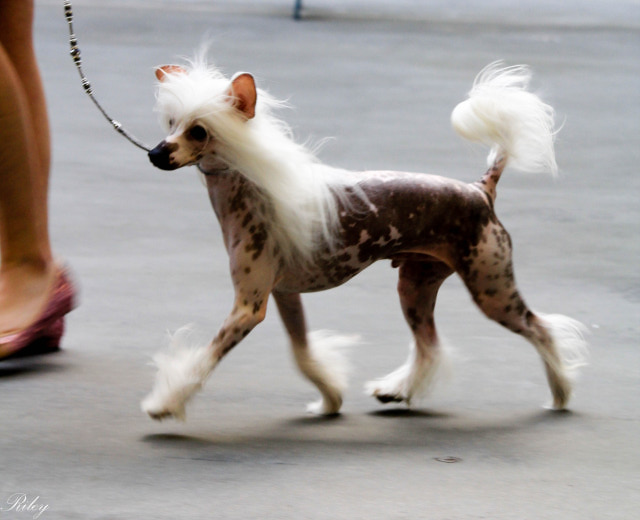 Territory Marking
QuestionHi Kathleen and thank you in advance.
I have a
Territory Marking
QuestionHi Kathleen and thank you in advance.
I have a
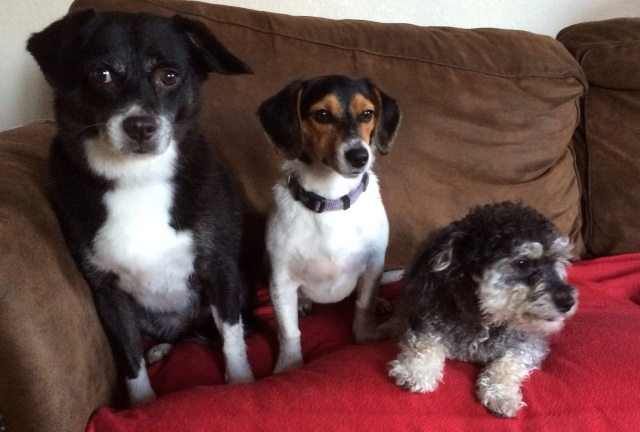 Dog aggression
Question
The 3 of them
I have 3 spayed female do
Dog aggression
Question
The 3 of them
I have 3 spayed female do
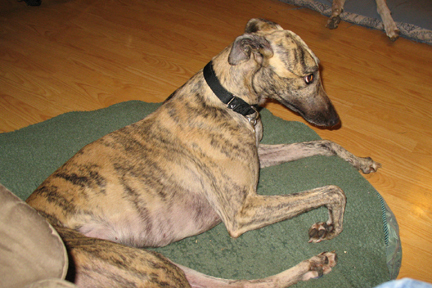 Adult Greyhound Howling
Question
Lisette
Hello Kathleen,
Thank you for taking
Adult Greyhound Howling
Question
Lisette
Hello Kathleen,
Thank you for taking
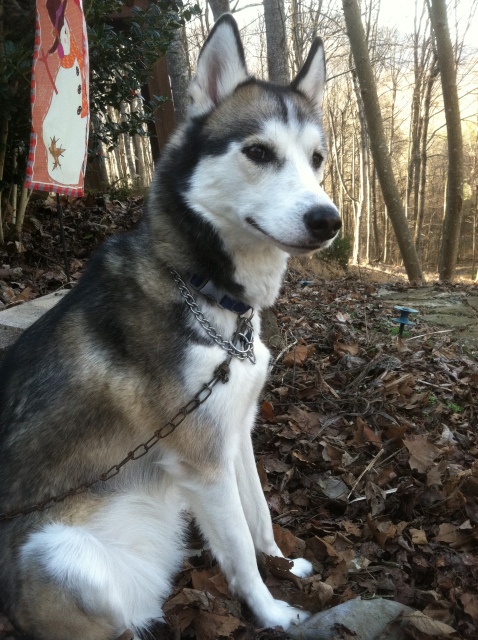 Is putting my dog in a cage a good form of punishment?
Question
Blue
My Siberian husky, Blue, as been b
Is putting my dog in a cage a good form of punishment?
Question
Blue
My Siberian husky, Blue, as been b